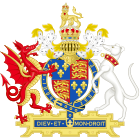Submission of the Clergy Act 1533 facts for kids

|
|
| Long title | An Acte for the Submission of the Clergie to the Kynges Majestie. |
|---|---|
| Citation | 25 Hen. 8. c. 19 |
|
Status: Amended
|
|
| Revised text of statute as amended | |
The Submission of the Clergy Act 1533 was an important law made by the Parliament in 1533. It helped change the relationship between the King of England and the Church. This law made sure that the King had more power over the Church in England.
Parts of this old law are still in effect in Great Britain today. However, many sections have been updated or removed over the years by newer laws.
Contents
What Was This Law About?
This law, known as the Submission of the Clergy Act, was passed during the reign of King Henry VIII. It was a big step in the English Reformation. This was a time when England broke away from the authority of the Pope in Rome.
The Act made it clear that the Church in England had to follow the King's rules. It meant that the clergy (church leaders) had to "submit" to the King's authority.
Why Was This Law Important?
Before this Act, the Church often made its own laws, called Canons, without the King's full approval. This Act changed that. It said that the Church could not make new laws or put them into action without the King's permission.
It also made sure that no church laws could go against the King's special powers (called the Royal Prerogative). They also could not go against the customs, laws, or other rules of England. This gave the King a lot more control over religious matters in the country.
What Parts of the Law Are Still Used?
Even though it's a very old law, some key parts of the Submission of the Clergy Act 1533 are still important today. Specifically, sections 1 and 3 of the Act are still in force.
Rules for Church Laws
These sections say that the Church of England's main governing body, called the General Synod, must follow certain rules when making its own laws (Canons).
- They need the King or Queen's approval and permission to create and use these church laws.
- The church laws they make cannot go against the special powers of the King or Queen.
- They also cannot go against the customs, laws, or other rules of England.
This means that even today, the Church of England's rules must fit within the country's laws and the monarch's authority.
What Happened to Other Parts?
Many other parts of the original Act have been removed or changed over time. For example, a law from 1969, called the Statute Law (Repeals) Act 1969, cancelled most of the Act, except for sections 1 and 3. Other sections, like sections 4, 5, and 6, were also repealed by different laws in the 1940s and 1960s. This shows how laws are updated as times change.

